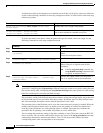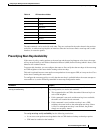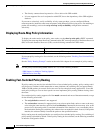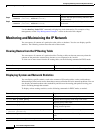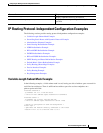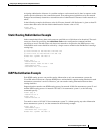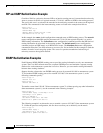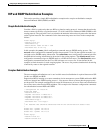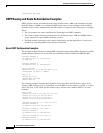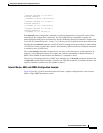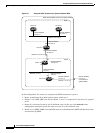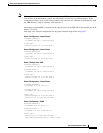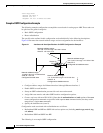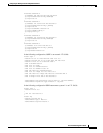
Configuring IP Routing Protocol-Independent Features
IP Routing Protocol-Independent Configuration Examples
IPC-382
Cisco IOS IP Configuration Guide
RIP and IGRP Redistribution Example
Consider a WAN at a university that uses RIP as an interior routing protocol. Assume that the university
wants to connect its WAN to a regional network, 172.16.0.0, which uses IGRP as the routing protocol.
The goal in this case is to advertise the networks in the university network to the routers on the regional
network. The commands for the interconnecting router are listed in the example that follows:
router igrp 1
network 172.16.0.0
redistribute rip
default-metric 10000 100 255 1 1500
distribute-list 10 out rip
In this example, the router global configuration command starts an IGRP routing process. The network
router configuration command specifies that network 172.16.0.0 (the regional network) is to receive
IGRP routing information. The redistribute router configuration command specifies that RIP-derived
routing information be advertised in the routing updates. The default-metric router configuration
command assigns an IGRP metric to all RIP-derived routes. The distribute-list router configuration
command instructs the Cisco IOS software to use access list 10 (not defined in this example) to limit the
number of entries in each outgoing update. The access list prevents unauthorized advertising of
university routes to the regional network.
EIGRP Redistribution Examples
Each Enhanced IGRP (EIGRP) routing process provides routing information to only one autonomous
system. The Cisco IOS software must run a separate EIGRP process and maintain a separate routing
database for each autonomous system that it services. However, you can transfer routing information
between these routing databases.
Suppose that the software has one EIGRP routing process for network 10.0.0.0 in autonomous system
71 and another EIGRP routing process for network 192.168.7.0 in autonomous system 1, as the
following commands specify:
router eigrp 71
network 10.0.0.0
router eigrp 1
network 192.168.7.0
To transfer a route from 192.168.7.0 into autonomous system 71 (without passing any other information
about autonomous system 1), use the command in the following example:
router eigrp 71
redistribute eigrp 1 route-map 1-to-71
route-map 1-to-71 permit
match ip address 3
set metric 10000 100 1 255 1500
access-list 3 permit 192.168.7.0
The following example is an alternative way to transfer a route to 192.168.7.0 into autonomous system
71. Unlike the previous configuration, this one does not allow you to arbitrarily set the metric.
router eigrp 71
redistribute eigrp 1
distribute-list 3 out eigrp 1
access-list 3 permit 192.168.7.0



